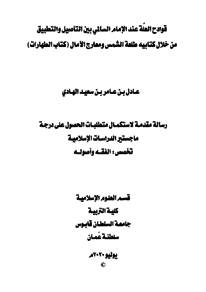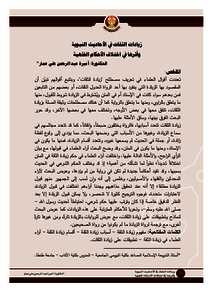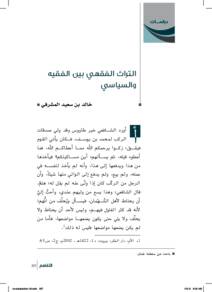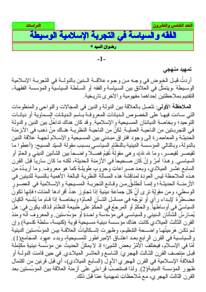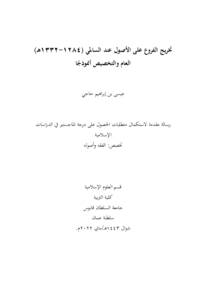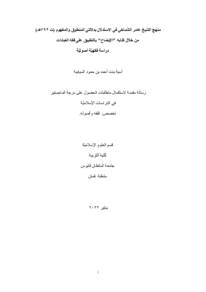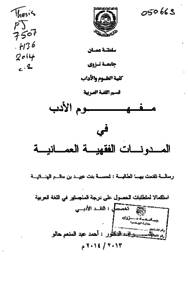Document
قوادح العلة عند الإمام السالمي بين التأصيل والتطبيق من خلال كتابيه طلعة الشمس ومعارج الآمال (كتاب الطهارات).
Other titles
The Refutations of Reason according to Imam Assalimi between Rooting and Application throughout his Books, "Tala't Ashams" and "Ma'arij Alaamaal" (Book of Purity)
Publisher
جامعة السلطان قابوس.
Gregorian
2020
Language
Arabic
Subject
English abstract
The research aims to show the refutations of the reasons that Imam Assalimi has
rooted in his book Tala't Ashams and to compare his rooting of the rules (Alqawaid)
with his jurisprudential applications on them. That is to demonstrate the extent to
which his rooting of these rules in the Tala't Ashams corresponds to its applications
in the Book of Purity from his book Ma'arij Alaamaal.
The research consists of two chapters. The first chapter looks at Imam Assalimi's
rooting of these refutations of reasons, and the second discussses his applications of
refutations of reasons.
The results of this study have shown that Imam Assalimi has defined the concept of
reason (Illah) as the one that identifies the ruling or as "rule identifier". Moreover,
the effect of selecting this definition by Imam Assalimi was clearly seen in a number
of issues pertaining to reasons (Illah) such as the permissibility of reasoning using
the limited reason (Illah Qasirah), permissibility of reasoning the legal ruling using
another legal ruling, permissibility to delay the reason (Illah) after the original ruling,
and the permissibility of absolute reasoning using the non-existent reason.
Imam Assalimi has listed 25 refutations although he mentioned other two meanings
for the breaking refutation, which makes them 26. He also mentioned that the
objections are not limited to the refutations he mentioned but he approved 25 and
rejected one which is described as the breaking one. That one is the one that shows
the wisdom behind some issues but does not have a reason or a ruling.
The applications of the refutations of reasons that Imam Assalimi used in his book in
Ma'arij Alaamal were compatible with what he had rooted in Tala't Ashams.
However, his rooting of those rules were in compatible with his applications when it
comes to the issue of the using deductive analogy (qias) of ablution of the Prayer
(wudhu) with ablution using soil (tayamum). He refused it here because it is using
deductive analogy (qiyas) of the original ablution instead of the alternative
(tayammum) although he has allowed it when he mentioned the conditions of reason
(Illah).
There are other jurisprudential applications that appeared in Ma'arij Alaamal that
Imam Assalimi has not mentioned among the ones he mentioned in Tala't Ashams
and they are of three types:
The first type is not approving some types of deductive analogy (qiyas) such as
reasoning using the names, affirming the cause by deductive analogy (qiyas), and
deductive analogy (qiyas) in acts of worships (Ibadat).
The second type refers to the absence of one of the conditions, such as the absence of
the condition that the original should not be used before the branch, which is not a
condition taken by Imam Assalimi, and the absence of a condition of equal judgment
between the original and the branch of ruling.
The third type: the division that Assalimi had ignored. It is mentioned by a number
of scholars of fundamental of Jurisprudence
Member of
Resource URL
Arabic abstract
إن هذه الرسالة المعنونة بـ : ( الفروق الفقهية عند الإباضية في بابي الطهارة والصلاة ـ جمعًا ودراسة) تهدف إلى بيان الفروق الفقهية عند الإباضية، وأنهم وإن لم يعتنوا بها تأليفًا وتنظيرًا ـ كما صنعت بعض المدارس الفقهيةـ فقد اعتنوا بها تطبيقًا؛ فذكروا الفرق الأصولي كقادح من قوادح العلة، والفرق الفقهي كفارق بين المسائل الفرعية المتفقة صورة والمختلفة حكمًا ومعنى، وهذا الأخير مما كان للإباضية سبق بالاعتناء به.
وهي تحاول أن تجيب عن الأسئلة التالية:
أولًا: متى وكيف نشأ علم الفروق الفقهية؟
ثانيًا: ما أهمية علم الفروق الفقهية، وما ثمرة دراسته، وما العلاقة بينه وبين العلوم المشابهة له؟
ثالثًا: هل اعتنى الإباضية بالفروق الفقهية؟
وتوصلت إلى نتائج عدة، من أهمها:
ـ ظهر علم الفروق الفقهية مبكرًا مع نزول القرآن الكريم، وورود السنة النبوية على صاحبها الصلاة والسلام.
ـ الإباضية من السابقين إلى تدوين الفروق الفقهية في مصنفاتهم.
ـ يُعدُّ السالمي من أبرز فقهاء الإباضية الذين اعتنوا بالفروق الفقهية في كتابه (معارج الآمال).
وقد اتبع الباحث في دراسته هذه المنهجين الآتيين:
ـ المنهج الاستقرائي: وذلك باستقراء وتتبع الفروق الفقهية المتعلقة ببابي الطهارة والصلاة.،
ـ المنهج التحليلي: وذلك بدراسة الفرق الفقهي، وذكر الرأي المختار للباحث غالبًا.
وهي تحاول أن تجيب عن الأسئلة التالية:
أولًا: متى وكيف نشأ علم الفروق الفقهية؟
ثانيًا: ما أهمية علم الفروق الفقهية، وما ثمرة دراسته، وما العلاقة بينه وبين العلوم المشابهة له؟
ثالثًا: هل اعتنى الإباضية بالفروق الفقهية؟
وتوصلت إلى نتائج عدة، من أهمها:
ـ ظهر علم الفروق الفقهية مبكرًا مع نزول القرآن الكريم، وورود السنة النبوية على صاحبها الصلاة والسلام.
ـ الإباضية من السابقين إلى تدوين الفروق الفقهية في مصنفاتهم.
ـ يُعدُّ السالمي من أبرز فقهاء الإباضية الذين اعتنوا بالفروق الفقهية في كتابه (معارج الآمال).
وقد اتبع الباحث في دراسته هذه المنهجين الآتيين:
ـ المنهج الاستقرائي: وذلك باستقراء وتتبع الفروق الفقهية المتعلقة ببابي الطهارة والصلاة.،
ـ المنهج التحليلي: وذلك بدراسة الفرق الفقهي، وذكر الرأي المختار للباحث غالبًا.
Category
Theses and Dissertations

